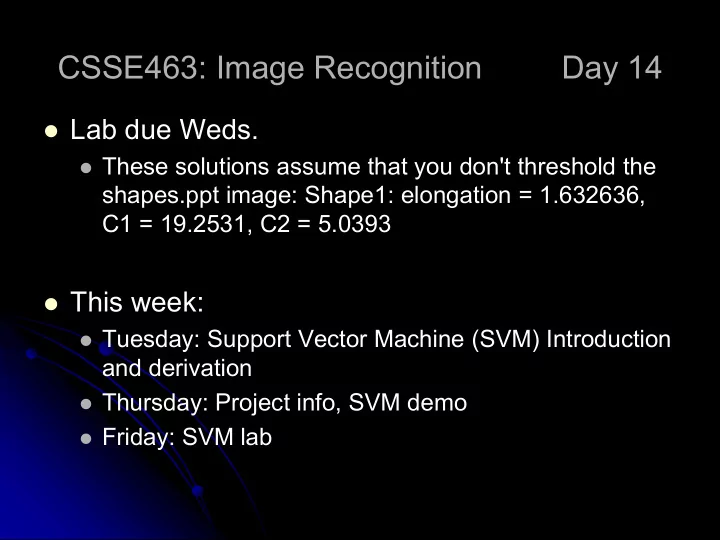

CSSE463: Image Recognition Day 14 Lab due Weds. These solutions assume that you don't threshold the shapes.ppt image: Shape1: elongation = 1.632636, C1 = 19.2531, C2 = 5.0393 This week: Tuesday: Support Vector Machine (SVM) Introduction and derivation Thursday: Project info, SVM demo Friday: SVM lab
Feedback on feedback Delta Plus Want to see more code Really like the material (lots) Math examples caught off guard, Covering lots of ground but OK now. Labs! Tough if labs build on each other Quizzes 2 b/c no feedback until lab returned. Challenging and interesting Project + lab in same week is Enthusiasm slightly tough Slides Include more examples Groupwork Application in MATLAB takes time. Want to learn more Pace: Lectures and assignments: OK – slightly fast
SVMs: “Best” decision boundary Consider a 2- class problem Start by assuming each class is linearly separable There are many separating hyperplanes… Which would you choose?
SVMs: “Best” decision boundary The “best” hyperplane is the one that maximizes the margin, r , between the classes. Some training points will always margin lie on the margin r These are called “support vectors” #2,4,9 to the left Why does this name make sense intuitively? Q1
Support vectors The support vectors are the toughest to classify What would happen to the decision boundary if we moved one of them, say #4? A different margin would have maximal width! Q2
Problem Maximize the margin width while classifying all the data points correctly…
Mathematical formulation of the hyperplane On paper Key ideas: T Optimum separating w x b 0 0 hyperplane: T g ( x ) w x b Distance to margin: 0 0 2 Can show the margin r w width = 0 Want to maximize margin Q3-4
Finding the optimal hyperplane We need to find w and b T d ( w x b ) 1 for i 1 , 2 ,.... N that satisfy the system of i i inequalities: 1 T ( w ) w w where w minimizes the 2 cost function: (Recall that we want to minimize ||w 0 ||, which is equivalent to minimizing ||w o || 2 =w T w) Quadratic programming problem Use Lagrange multipliers Switch to the dual of the problem
Non-separable data Allow data points to be misclassifed But assign a cost to each misclassified point. The cost is bounded by the parameter C (which you can set) You can set different bounds for each class. Why? Can weigh false positives and false negatives differently
Can we do better? Cover’s Theorem from information theory says that we can map nonseparable data in the input space to a feature space where the data is separable, with high probability, if: The mapping is nonlinear The feature space has a higher dimension The mapping is called a kernel function . Lots of math would follow here
Most common kernel functions T p K ( x , x ) ( x x 1 ) i i Polynomial 1 2 K ( x , x ) exp x x Gaussian Radial-basis i i s 2 2 function (RBF) b b T K ( x , x ) tanh x x Two-layer perceptron i 0 i 1 You choose p, s , or b i My experience with real data: use Gaussian RBF! Easy Difficulty of problem Hard p=1, p=2, higher p RBF Q5
Recommend
More recommend